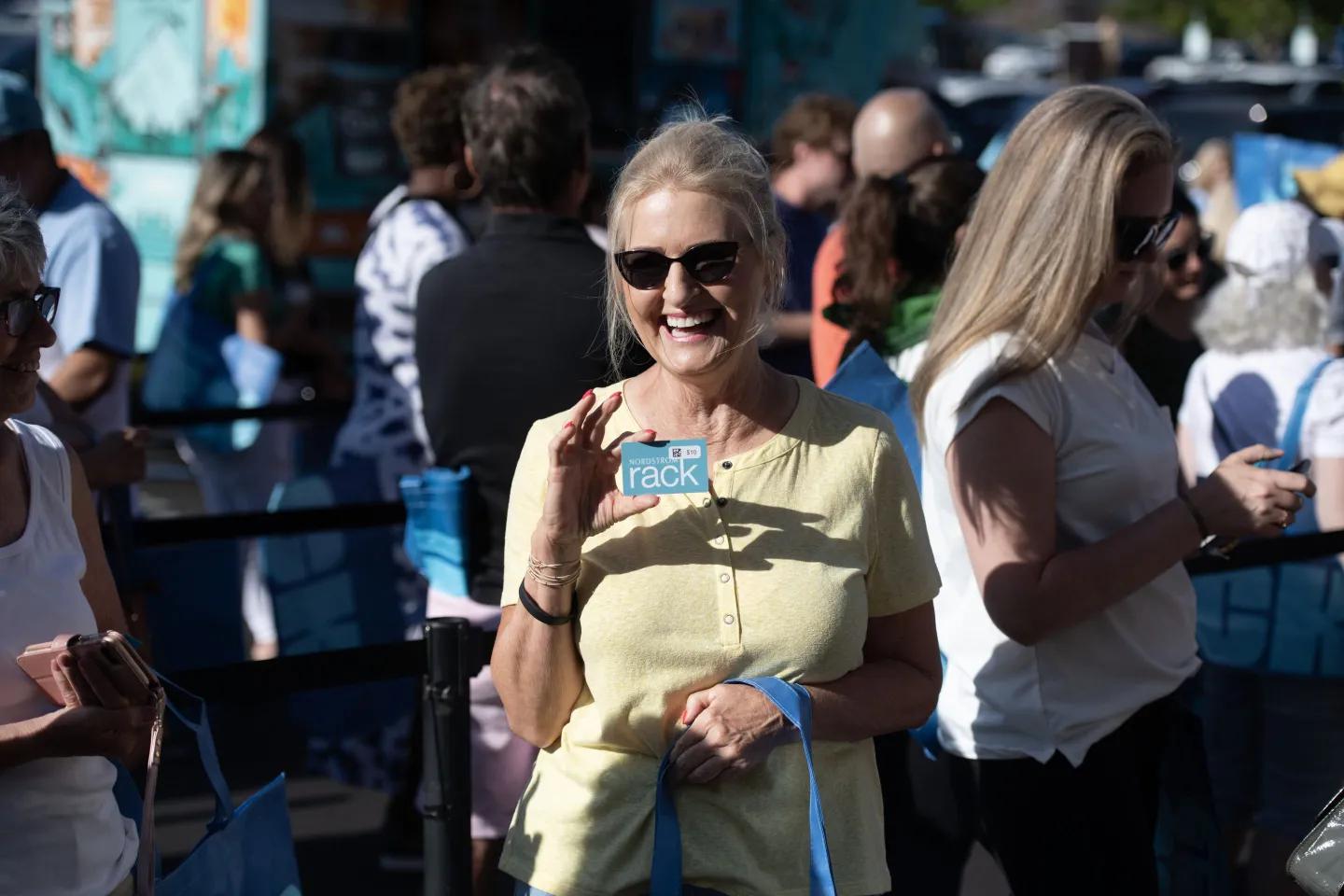 诺德斯特龙的忠诚计划会员纷纷抓住促销机会购物,成为公司季度亏损的原因之一。图片来源:TOM COOPER/GETTY IMAGES FOR NORDSTROM RACK
诺德斯特龙的忠诚计划会员纷纷抓住促销机会购物,成为公司季度亏损的原因之一。图片来源:TOM COOPER/GETTY IMAGES FOR NORDSTROM RACK诺德斯特龙(Nordstrom)的Nordy Club忠诚计划备受欢迎,该计划的会员积攒了太多忠诚积分,以至于影响到该服装零售商的盈利。
位于西雅图的诺德斯特龙在5月30日公布的亏损情况,比预期更加严重。该公司将部分原因归咎于信用卡用户积攒了太多奖励积分,超出了公司的预测。诺德斯特龙第一季度净亏损3,900万美元,毛利润率下降2.25%,降至31.6%,而亏损的部分原因就是顾客积攒的大量积分。供应链盗窃和公司周年促销前增加的库存,也造成了公司的亏损。
但诺德斯特龙的高管并不担心客户忠诚计划所带来的问题。公司首席财务官凯西·史密斯表示,顾客参与忠诚计划的时间最终会与“递延收入”扯平,“递延收入将推动未来的销售和利润”。公司的业绩报告显示,忠诚客户购物占公司总销售额的近70%。
史密斯说道:“我们的忠诚计划或Nordy Club的销售强劲是件好事。只是本季度的销售额略有下降,但我们未来会恢复这种强劲的势头。因此,这是一种变相的积极因素。它会对我们这个季度的业绩有所影响,但在今年剩余时间里我们会恢复增长。”
诺德斯特龙没有向《财富》杂志透露Nordy Club的会员数量,但该计划一直是公司强大客户服务精神的重要组成部分,也是一个重要的客户参与工具。诺德斯特龙于2018年推出该计划,作为顾客赚取积分的一种方式,积分可以用来兑换折扣。在该计划推出之前,诺德斯特龙之前的奖励模式拥有1,000多万活跃会员,他们的消费额是非会员的4倍。去年8月,诺德斯特龙报告称,90%的Nordy Club顶级会员在周年庆促销活动中购物。
“积分可能被清零”
尽管诺德斯特龙预计客户忠诚计划带来的损失在下一个季度会自我修正,但霍特国际商学院(Hult International Business school)市场营销教授卡琳·庞对《财富》杂志表示,Nordy Club不太可能成为该零售商财务健康状况好坏的决定性因素。庞教授表示,顾客在购物时,尽管可能获得积分并将其兑现,但他们购买的商品价值已经超过了积分奖励的价值。此外,Nordy Club的积分和兑换券在一年后就会过期,很多顾客会忘记它们的存在。
庞教授表示:“积分可能被清零。”
她认为,在服装零售业,忠诚度计划的影响已经有所减弱。根据SAP Emarsys的客户忠诚度指数,去年品牌忠诚度下降了14%,有59%的消费者表示会选择更便宜的商品,有18%的消费者表示,他们没有条件保持忠诚。
事实上,包括Nordy Club在内的许多零售商已经全面调整或重新推出了他们的忠诚计划,增加了节日礼品和更多积分等福利,以扭转这一趋势。彭尼百货(JCPenney)在4月份推出了一项忠诚计划,宣布投入5亿美元的激励计划,从而与竞争对手科尔士百货(Kohl's)的Cash计划竞争。但是,这些忠诚度计划并没有成为吸引购物者的因素,其作用反而因为竞争对手推出基本相同的计划而被抵消。
庞教授表示:“现在每家公司都有激励计划,这些计划似乎千篇一律。市场被稀释,没有差异化因素”。
“如果激励消失了,你会更换商家”
加州大学河滨分校(University of California at Riverside)工商管理学院营销学教授苏布尼马尼安·“巴拉”·巴拉钱德尔对《财富》杂志表示,忠诚计划依旧有可能成为吸引和留住顾客的有效工具。他表示,虽然忠诚计划可以产生行为忠诚度,但消费者会出于方便继续从其加入忠诚计划的零售商购物,而不会与品牌产生更深层次的情感联系。
他说道:“人们只是被激励去积累积分,以获得免费的奖励,这会影响零售商的利润,他们并不是因为真正看重品牌或商品而愿意支付价格。
因此,巴拉钱德尔表示,忠诚计划岌岌可危。如果消费者的情况发生变化,实际条件决定了他们无法再去一家商店购物,那么忠诚计划基本上毫无用处。
他表示:“如果激励消失了,你会更换商家”
近年来,包括备受喜爱的街头服饰品牌Kith和青少年时尚连锁店Claire’s在内的一些零售商都在努力消除这种影响。它们改为采用不同专属等级的忠诚计划模式,让会员先于普通大众买到定制产品或新商品。
营销策略平台Sooth的创始人伊恩·贝尔对《现代零售》表示,这种策略更能迎合消费者的心理。
他说道:“[把]一些真正独特的、有益的、令人难忘的东西摆在顾客面前,可以建立起一种情感纽带,而[纯粹的]交易关系永远无法做到这一点。”(财富中文网)
翻译:刘进龙
审校:汪皓
诺德斯特龙(Nordstrom)的Nordy Club忠诚计划备受欢迎,该计划的会员积攒了太多忠诚积分,以至于影响到该服装零售商的盈利。
位于西雅图的诺德斯特龙在5月30日公布的亏损情况,比预期更加严重。该公司将部分原因归咎于信用卡用户积攒了太多奖励积分,超出了公司的预测。诺德斯特龙第一季度净亏损3,900万美元,毛利润率下降2.25%,降至31.6%,而亏损的部分原因就是顾客积攒的大量积分。供应链盗窃和公司周年促销前增加的库存,也造成了公司的亏损。
但诺德斯特龙的高管并不担心客户忠诚计划所带来的问题。公司首席财务官凯西·史密斯表示,顾客参与忠诚计划的时间最终会与“递延收入”扯平,“递延收入将推动未来的销售和利润”。公司的业绩报告显示,忠诚客户购物占公司总销售额的近70%。
史密斯说道:“我们的忠诚计划或Nordy Club的销售强劲是件好事。只是本季度的销售额略有下降,但我们未来会恢复这种强劲的势头。因此,这是一种变相的积极因素。它会对我们这个季度的业绩有所影响,但在今年剩余时间里我们会恢复增长。”
诺德斯特龙没有向《财富》杂志透露Nordy Club的会员数量,但该计划一直是公司强大客户服务精神的重要组成部分,也是一个重要的客户参与工具。诺德斯特龙于2018年推出该计划,作为顾客赚取积分的一种方式,积分可以用来兑换折扣。在该计划推出之前,诺德斯特龙之前的奖励模式拥有1,000多万活跃会员,他们的消费额是非会员的4倍。去年8月,诺德斯特龙报告称,90%的Nordy Club顶级会员在周年庆促销活动中购物。
“积分可能被清零”
尽管诺德斯特龙预计客户忠诚计划带来的损失在下一个季度会自我修正,但霍特国际商学院(Hult International Business school)市场营销教授卡琳·庞对《财富》杂志表示,Nordy Club不太可能成为该零售商财务健康状况好坏的决定性因素。庞教授表示,顾客在购物时,尽管可能获得积分并将其兑现,但他们购买的商品价值已经超过了积分奖励的价值。此外,Nordy Club的积分和兑换券在一年后就会过期,很多顾客会忘记它们的存在。
庞教授表示:“积分可能被清零。”
她认为,在服装零售业,忠诚度计划的影响已经有所减弱。根据SAP Emarsys的客户忠诚度指数,去年品牌忠诚度下降了14%,有59%的消费者表示会选择更便宜的商品,有18%的消费者表示,他们没有条件保持忠诚。
事实上,包括Nordy Club在内的许多零售商已经全面调整或重新推出了他们的忠诚计划,增加了节日礼品和更多积分等福利,以扭转这一趋势。彭尼百货(JCPenney)在4月份推出了一项忠诚计划,宣布投入5亿美元的激励计划,从而与竞争对手科尔士百货(Kohl's)的Cash计划竞争。但是,这些忠诚度计划并没有成为吸引购物者的因素,其作用反而因为竞争对手推出基本相同的计划而被抵消。
庞教授表示:“现在每家公司都有激励计划,这些计划似乎千篇一律。市场被稀释,没有差异化因素”。
“如果激励消失了,你会更换商家”
加州大学河滨分校(University of California at Riverside)工商管理学院营销学教授苏布尼马尼安·“巴拉”·巴拉钱德尔对《财富》杂志表示,忠诚计划依旧有可能成为吸引和留住顾客的有效工具。他表示,虽然忠诚计划可以产生行为忠诚度,但消费者会出于方便继续从其加入忠诚计划的零售商购物,而不会与品牌产生更深层次的情感联系。
他说道:“人们只是被激励去积累积分,以获得免费的奖励,这会影响零售商的利润,他们并不是因为真正看重品牌或商品而愿意支付价格。
因此,巴拉钱德尔表示,忠诚计划岌岌可危。如果消费者的情况发生变化,实际条件决定了他们无法再去一家商店购物,那么忠诚计划基本上毫无用处。
他表示:“如果激励消失了,你会更换商家”
近年来,包括备受喜爱的街头服饰品牌Kith和青少年时尚连锁店Claire’s在内的一些零售商都在努力消除这种影响。它们改为采用不同专属等级的忠诚计划模式,让会员先于普通大众买到定制产品或新商品。
营销策略平台Sooth的创始人伊恩·贝尔对《现代零售》表示,这种策略更能迎合消费者的心理。
他说道:“[把]一些真正独特的、有益的、令人难忘的东西摆在顾客面前,可以建立起一种情感纽带,而[纯粹的]交易关系永远无法做到这一点。”(财富中文网)
翻译:刘进龙
审校:汪皓
Members of Nordstrom’s popular Nordy Club have accumulated so many loyalty points that it’s impacting the clothing retailer’s bottom line.
The Seattle-based merchant reported on May 30 a worse-than-expected loss in part because Nordstrom credit card-holders accumulated more reward points than the company anticipated. Nordstrom posted a $39 million first-quarter net loss and a 2.25% dip in gross profit to 31.6% in part because of the points-accumulation boom. Supply chain theft and increased inventory ahead of the company’s July anniversary sale also contributed to the loss.
But Nordstrom executives were not concerned with the loyalty program issue, with CFO Cathy Smith saying the timing of the loyalty engagement will eventually even out with “deferred revenue that will drive sales and profit in future periods.” Per the company’s earnings, purchases made by loyal customers were nearly 70% of the company’s total sales.
“Strength in our loyalty or Nordy Club sales is a good thing. It just will be a little bit of a reserve this quarter, but we’ll see that strength continue to come back,” Smith said. “So that’s a positive, kind of in disguise. It will impact us this quarter, but it will come back [in] the remainder of the year.”
Nordstrom did not disclose to Fortune how many members Nordy Club has, but the program has been an important part of the company’s ethos of strong customer service and a key engagement tool. Launched in 2018, Nordy Club was a way for customers to earn points which convert to Notes to redeem for discounts. Before the launch of the program, Nordstrom had more than 10 million active members of its previous rewards model who spent four times more than non-members. Last August, Nordstrom reported 90% of its top-tier Nordy Club members shopped at its anniversary sale.
‘It’s probably going to wash out’
But beyond Nordstrom expecting loyalty program losses to self-correct by next quarter, the Nordy Club itself is unlikely to be the defining factor in the retailer’s financial health for better or worse, Caryn Pang, professor of marketing at the Hult International Business school, tells Fortune. When customers shop—though they may acquire and cash in points— they’re already purchasing more than the point rewards are worth, Pang says. Moreover, Nordy Club’s currency of points and notes expire after a year, with many customers simply forgetting they exist.
“It’s probably going to wash out,” Pang says.
The impact of loyalty programs more broadly has weakened in the clothing retail industry, she argued. Brand loyalty decreased 14% last year, according to SAP Emarsys’s Customer Loyalty Index, with 59% of consumers saying they’d switch over to products if they were cheaper, and 18% saying being loyal is something they can’t afford to do.
Indeed, numerous retailers, including Nordy Club, have overhauled or relaunched their loyalty programs to incorporate greater perks, like holiday gifts and even more points, to reverse this trend. JCPenney launched a loyalty program in April, announcing $500 million in incentives to rival its competitor Kohl’s Cash. But rather than being an enticing factor for shoppers, these loyalty programs are instead being canceled out by competitors that have essentially introduced the same programs.
“Everybody has an incentive program now, and the incentive programs seem to be very similar,” Pang said. “The market is diluted, and there’s no differentiating factor in the market.”
‘If the incentive was gone, you would switch’
There is still a way for loyalty programs to be an effective tool in customer engagement and retention, Subramanian “Bala” Balachander, professor of marketing at the University of California at Riverside School of Business Administration, tells Fortune. While loyalty programs can generate behavioral loyalty, consumers will continue to purchase items from the retailer of which they are a member out of convenience—they don’t generate deeper emotional connections to a brand, he says.
“People are just being motivated to accumulate points in order to get free stuff which impacts profit, rather than being willing to pay the price because they really value the brand or the merchandise,” he says.
Loyalty programs are therefore in precarious spots, Balachandar says. Should a consumer’s circumstances change and it’s no longer practical to shop at a store, their loyalty program is essentially useless.
“If the incentive was gone, you would switch,” he says.
In recent years, some retailers including streetwear apparel darling Kith and tween fashion chain Claire’s have worked to combat this effect. They’ve pivoted to loyalty program models with tiers of exclusivity, giving members access to customized products or new items before the general public. Ian Baer, founder of marketing strategy platform Sooth, told Modern Retail this strategy better appeals to consumers’ psyche.
“[Putting] something really uniquely beneficial and memorable in front of a customer builds the sort of emotional bond that a [purely] transactional relationship never can,” he said.






